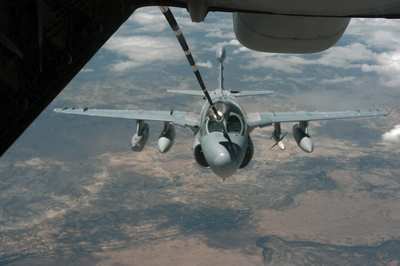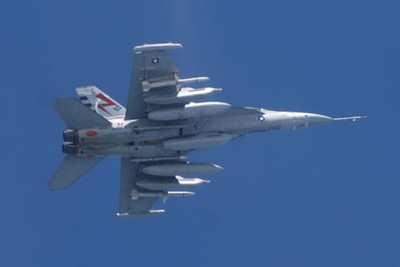Jams Signals From Cell Phones, Garage Door Openers
It first appeared at the end of the Vietnam conflict and served
in Kosovo and during the first Gulf war. Its electronic warfare
system is considered so valuable by the Pentagon, it makes sure no
US aircraft carrier goes into battle without a few on board.

The primary function of the EA-6B Prowler up till now has been
to escort US attack jets while jamming the enemy radios, hostile
radars and air defense batteries aimed at them, according to the
Associated Press.
Today, it has been redefined to take on a new mission: jamming
ground signals from devices such as mobile phones and garage door
openers that act as detonators for improvised explosive devices
(IED), said U.S. Navy Capt. David Woods.
Although its success is difficult to measure, the Prowler is
thought to be one of the most effective weapons against the biggest
threat to a soldier's life: roadside bombs.

Woods, one of the Navy's most experienced Prowler pilots,
believes the aircraft is making a difference. "When it's flying we
have greater success and fewer IEDs going off," he said. "It's kind
of an insurance policy."
Capt. Woods is the commander of Carrier Air Wing 11, and says
there aren't many people who comprehend the Prowler's mission,
which is to control the electromagnetic spectrum. This task is so
critical, the Pentagon had the technology classified. Even the
crew's training is a tightly guarded secret.
The AP gathered information from outside experts that say
receivers inside the tail collect radio signals for computer
analysis. The threat is identified through a match in the
computer's extensive "threat library" database.
Once they know what they're dealing with, the crew of three
electronic countermeasures officers transmits electromagnetic
energy across a vast range of frequencies, including those from
television, radio and the internet, and jams the signal.

Woods said there are currently two Prowler squadrons at sea
somewhere in Mideast. One is on the USS John C. Stennis, and the
other is onboard the Nimitz. Two more are land-based in Iraq.
According to Woods, the Prowlers operate between 20,000 and
30,000 feet emitting its electromagnetic signals over areas with a
potential of insurgent roadside bombs.
The Prowler has one Achilles heel: its jamming gear is not
effective on bombs hard-wired to triggers. And for all its
usefulness, the Prowler is getting old. Acutely aware of this fact,
the Pentagon is testing its replacement: the EA-18G Growler.
As ANN reported, the Growler
made its first appearance in the Pacific Northwest at Naval Air
Station, Whidbey Island (NASWI) on April 9.
The Growler combines the capabilities of the F/A-18F Super
Hornet with the Prowler and will provide next-generation electronic
attack capability to the joint war fighter. The arrival marks the
first time fleet air crewmen and maintenance men got to lay their
hands on the new platform concept jet.
The Growler can achieve optimum speeds of Mach 1.8 and capable
of offensive electronic jamming, electronic emissions detection,
classification and monitoring; and electronic suppression of enemy
air defenses. Along with being a state of the art weapon system, it
also is economic by retaining 90 percent common parts with the
Super Hornet, while reducing the operational crew from four to
two.
The Pentagon is spending $9 billion on 90 of the next-generation
fighters, scheduled for entry into service by 2009 fully replacing
Prowler squadrons by 2013.

The Navy says signal jamming work will eventually be done with
unmanned aerial vehicles.
"People are excited about the arrival of the Growler, because it
is new," said Operation Specialist 1st Class (SW/AW) Jonathan
Fields, NASWI range and schedule department leading petty officer.
"Some of the service members may be sad to see the Prowler go, but
they are looking forward to see some of the advancements in the
Growler."
 ANN's Daily Aero-Term (04.25.24): Airport Rotating Beacon
ANN's Daily Aero-Term (04.25.24): Airport Rotating Beacon ANN's Daily Aero-Linx (04.25.24)
ANN's Daily Aero-Linx (04.25.24) Klyde Morris (04.22.24)
Klyde Morris (04.22.24) Airborne 04.24.24: INTEGRAL E, Elixir USA, M700 RVSM
Airborne 04.24.24: INTEGRAL E, Elixir USA, M700 RVSM Airborne 04.22.24: Rotor X Worsens, Airport Fees 4 FNB?, USMC Drone Pilot
Airborne 04.22.24: Rotor X Worsens, Airport Fees 4 FNB?, USMC Drone Pilot






